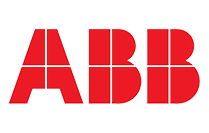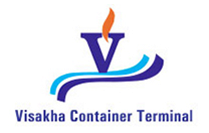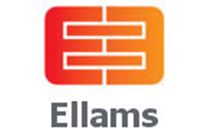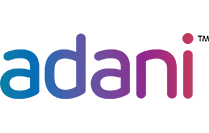VIDEO SURVEILLANCE FOR REDUCE SOLUTION COST
Security threats are growing day by day and so is the Video Surveillance Industry. With advancement of technology, the quality of cameras has seen a drastic improvement in the last 5 years. With each passing day, companies are coming up with higher resolution cameras. In the entire process, the most important aspect that determines your image quality in centralized monitoring is often ignored and that aspect is Bandwidth. The two major issues with Bandwidth are its availability and cost. Out of all the costs involved in Video Surveillance, bandwidth is the only recurring cost, and over a period of time, will become the highest contributor to the overall cost. Especially, when the installation is a multilocation one and the cost of Public and Static IP is significant. Installing high resolution cameras at the same time overlooking bandwidth will not do justice to your investments.
The second thing that we fail to realize is that higher the resolution, higher is the storage requirement, higher the storage costs. Since the early days of video surveillance industry, costs of cameras and devices has reduced drastically leading to more affordable solution. However, storage cost is the only cost that has not decreased, in fact, even increased over the years. It is therefore necessary to opt for a solution that optimizes storage, keeping your costs to the minimum.
BENEFITS
- No Public IP Required
- Edge Recording
- Intelligent Streaming
- Camera-wise Recording Flexibility
- Data Compression

SOLUTION
Record at local location, Monitor playback from Central Location
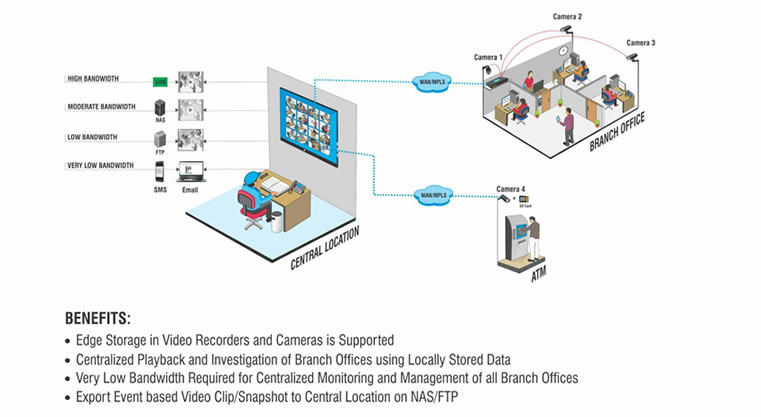
Bringing all the streams to the central location when you’re not actually monitoring all of them at the same time is simply wastage of bandwidth. At any given point of time, you would be monitoring only a few of them. In this case, the sensible thing to do would be record at the local location and monitor/playback from the central location. Hence, you will only be able to see the streams of cameras that are being monitored. Moreover, in case you are security sensitive and want backup, then you can opt for event based recording at the central location. Based on the availability of bandwidth, you can opt for four different options:
High Bandwidth: Pre and Post Event based Recording
Moderate Bandwidth: Audio and Alarm Notification with Video at Central Location
Low Bandwidth: Snapshot of Events on FTP/NAS
Very Low Bandwidth: SMS and E-mail Attachment with Snapshot
Adaptive Streaming
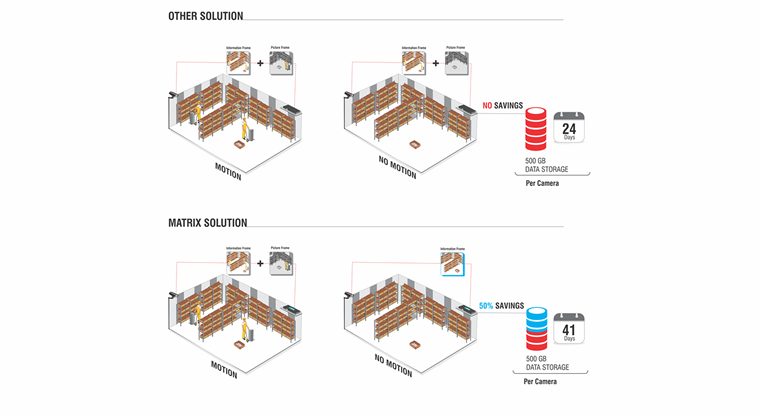
For a layman, watching a video is all about smooth movements. However, in reality, it’s not so smooth. A video is just a series of pictures flipped at a very high speed, usually 25 frames per second. Therefore, your camera generates 25 frames per second for you to see a smooth video. Now imagine a non-activity period, for e.g. Office premises after working hours, when there is no change in the scene but still your camera captures 25 frames per second. This results in criminal wastage of bandwidth and storage. You need smart cameras that automatically lower the frame rate during no activity period. This can save up to 50% of your bandwidth and eventually storage without any compromise in image quality.
Elimination of Public IP and Static IP
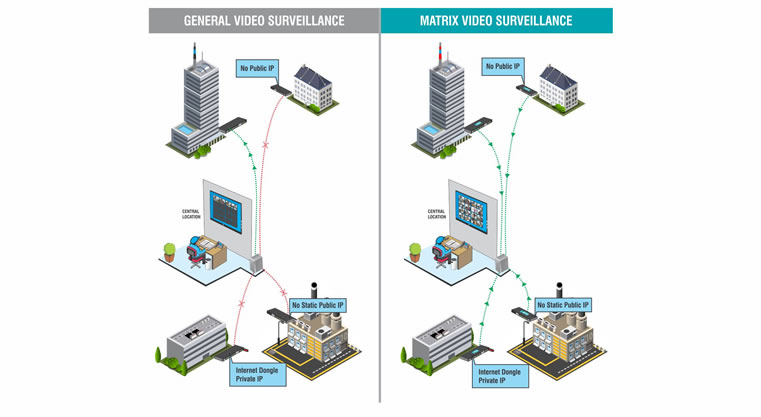
For centralized monitoring, most of the Video Surveillance systems present in the market asks you to purchase Public and Static IP for each location, which increases the cost of solution manifolds. To talk in layman language, Static IP is nothing but like a permanent contact number required for communication. In their system of communication, central location initiates connectivity to remote locations. Now see this in terms of one person trying to connect to multiple people across various geographies. This requires a permanent contact number for people. But if we reverse the process and multiple people across various geographies try to connect to that one person at a central location, a single contact number of that person will be required. Matrix Video Surveillance system with this architecture will save huge sums on Public and Static IP.
Flexibility of Camera-wise Recording Retention Days
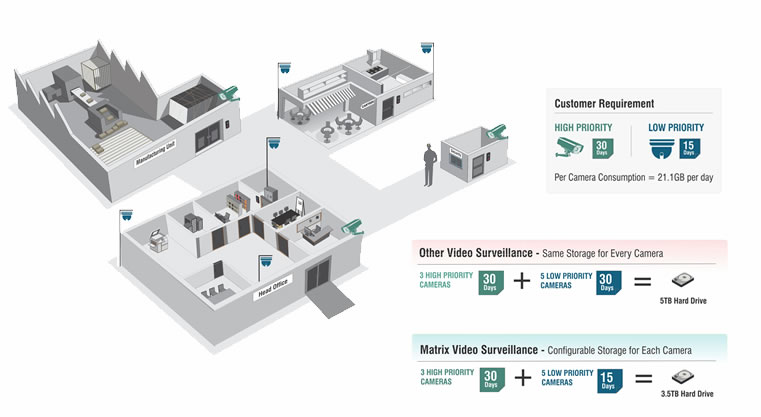
Most recorders do not allow you to distribute storage, thus assigning equal storage days for each camera. But your storage requirements for each camera are never the same. For example, in a manufacturing unit, one would like to record data of important cameras like those at the gates, reception and production line for higher number of days, say 60 days. While for low priority cameras, like those at the canteen or recreation room, recordings for a fortnight should be sufficient. Without camera-wise recording flexibility, for 60 days of recording data of camera at the production line camera you will have to store the canteen and recreation room camera data for 60 days as well. This will result in high storage costs. Matrix Video Recorders offer camera-wise recording flexibility, allowing users to define storage days for individual camera, thus saving on storage costs.
Two Level Data Compression and Archiving
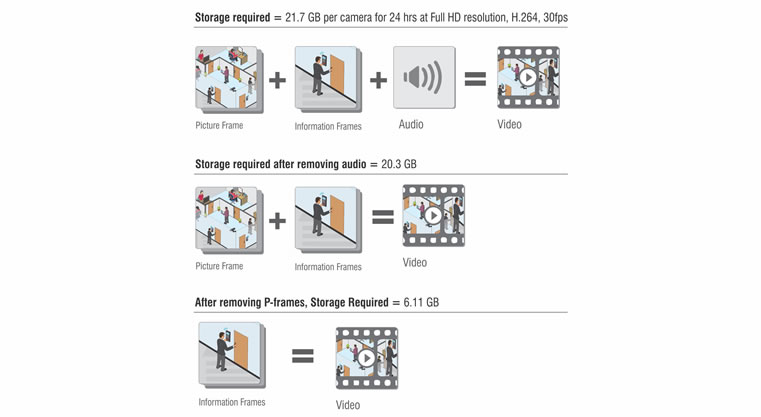
Nowadays, Government norms mandate some industries to store their CCTV recordings for a minimum of 60 to 90 days, especially Hospitality and Banking Industry. Now the problem is both these industries have a very high number of cameras, resulting in exponential increase in storage costs. Matrix Video Surveillance offers Two Level Data Compression, .i.e. you can remove audio in the first level of compression and p-frames in the second level of compression, thus saving your storage up to 70%. Moreover, the flexibility is offered camera-wise, i.e., for each camera you can define the number of days for first and second level of compression. This helps you meet all regulations without spending more on storage.
Customers
Resources
 Infograph
Infograph
Cascading Video Centralized Management and Monitoring without Server
Video Centralized Management and Monitoring without Server
 Application Note Cascading
Application Note Cascading
 Case Study Cascading
Case Study Cascading
 Mailer Cascading
Mailer Cascading
 Product Catalogue PProduct Catalogue
Product Catalogue PProduct Catalogue

